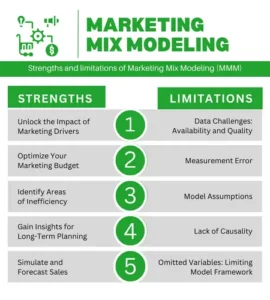Analysis of Marketing Mix Modeling – Advantages and Disadvantages
Marketing is a key business function to help differentiate products and services in today’s competitive global market. Businesses spend a fortune and pay attention to their budget towards growing, building, and maintaining relationships with their customers. It is imperative for retailers, manufacturers, consumer goods, banks, hospitals, etc. to optimize their marketing spend.
What is Marketing Mix Modeling?
Marketing Mix Modeling is a statistical technique for determining the effect of various marketing activities on sales or market share. It employs historical data to estimate the relationship between marketing inputs (e.g., advertising spend, promotions, price, etc.) and output (e.g., sales, market share) in order to assist businesses in making informed decisions about future marketing efforts and effectively allocating their marketing budget.
What does marketing mix modeling do?
MMM assists in determining the effectiveness of each marketing input in terms of ROI. In other words, a higher return on investment (ROI) marketing input is more effective as a medium than a lower ROI marketing input. Market Mix Modeling (MMM) assists businesses in accounting for every dollar they spend towards the product promotions and advertisement across the media campaigns and trade promotions. A marketing mix model’s main goal is to understand how various marketing activities initiatives influence a product’s business metrics. Brands use it as a tool for decision-making to determine the optimal allocation of financial resources towards the promotion of the products and make informed plan to get the optimized return for every dollar which they spend on business promotions.
Advantages Of Marketing Mix Modeling :
1. Understanding the impact of marketing drivers: MMM helps businesses understand how different media and trade drivers affect their sales.
2. Optimizing the marketing budget: It helps the leadership in identifying the tactics that are more effective and allows them to take informed decisions to drive better ROIs.
3. Identifying areas of inefficiency: It helps decision-makers optimize the reallocation of the marketing budget by appropriating spend across drivers which are suitable for their product markets.
4. Insights for long-term planning: Measurement tools and techniques allow businesses to identify the drivers to enhance their presence in unexplored territories.
5. Simulation and forecasting of sales: MMM allows to create a simulated set-up where businesses can test the impact of change in spend on their sales through a quasi-experiment.
Disadvantages Of Marketing Mix Modeling :

Despite its numerous benefits, MMM has some limitations, which are listed below:
1. Data availability and data quality: A robust estimation of MMM requires large amount of historical data to distinguish the variability in sales whether it is marketing driven or coming from business cycle fluctuations.
2. Measurement error: Often agencies capture the sales at store level while marketing activities are implemented at designated market areas. The heterogeneity in the unit of measurement between measurable media performance and business sales poses a challenge in setting up right econometric model.
3. Model assumptions: MMM relies on a number of assumptions such as independence between marketing drivers and the relationship between model variables. Often the model suffers from multicollinearity and endogeneity.
4. Lack of causality: MMM is a correlation model, so the direction of causality cannot be determined using this model.
5. Omitted variables: The implications of the MMM model revolves around the focus and control variables (financial indicators, weather, catastrophes, and global shocks such as Covid-19, and the financial crisis) that we consider in the model framework. Considering the dimensional challenges model framework often limits to a set of variables that leads to omitted variable bias.
How to choose the right Marketing Mix Modeling tools for business needs?
1. Identify the business goals and objectives: Before choosing a marketing mix modeling tool, it is important to have a clear understanding of what an individual business wants to achieve through marketing efforts. This will help in determining which tool will best align with the business goals and objectives.
2. Assess the data needs: The type of data needed to collect and analyze will also play a role in determining which tool to use. Some tools are better suited for certain types of data, such as social media or web analytics, while others may be more geared towards traditional marketing metrics like TV or print advertising.
3. Consider the complexity of business analysis: Some marketing mix modeling tools offer more advanced features and capabilities than others. If a business requires more complex analysis, such as multi-touch attribution, it may need a more robust tool.
4. Analyze the user interface: The tool that a company chooses should be simple to use and understand, with a user-friendly interface that allows it to access and analyse data quickly and easily.
5. Look for integrations: Many marketing mix modeling tools integrate with other software, such as data visualization tools or CRM systems. Consider what other tools a business is using and look for a marketing mix modeling tool that can integrate with it.
6. Consider the cost: The cost of marketing mix modeling tools can vary widely. Be sure to consider a budget and look for a tool that offers the features a business needs at a price that is affordable.
7. Leveraging the third party: Almost every business has an in-house monitoring and media planning department that looks after the media mix exercises. However, such practices are prone to model selection bias as the researchers considers the very set of parameters which they have considered earlier while making the market spending decision. Involving a third-party can help to come over the researcher generated biases as it broadens the scope of variables and depth of data-based insights. Bringing the capabilities of first-party data with third-party data demonstrates a holistic picture of the efficacy of various media campaigns.
Why choose Virtue Analytics?
At Virtue Analytics, we have expert data scientists and analysts on our team. Our team of data scientists and analysts are equipped with years of experience in the field and specialize in analyzing marketing expenditures. We can help you identify the most effective channels to boost your return on investment (ROI), making sure that every penny spent is put to good use. Don’t waste another dollar on ineffective marketing strategies – consult with Virtue Analytics and see how we can help you get the most out of your budget. Contact us today to learn more!


